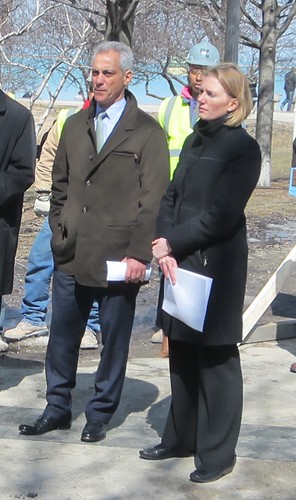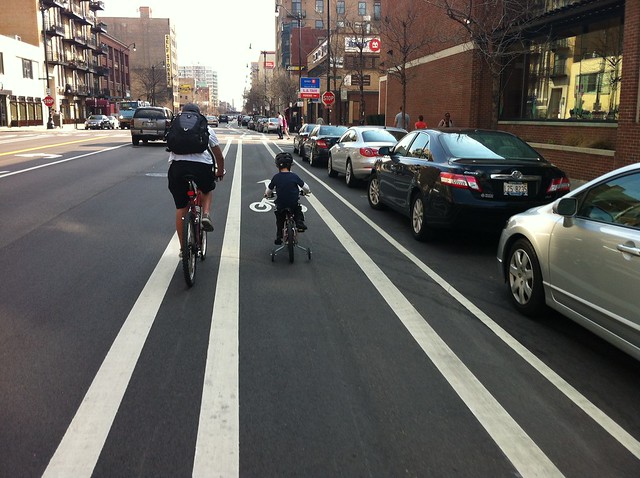
In this final installment of my interview with Chicago Department of Transportation Commissioner Rebekah Scheinfeld, we talked about the Divvy expansion, traffic cameras, protected bike lanes, and her overall goals as CDOT chief. Read the first and second parts of the interview here and here.
John Greenfield: We’re slated to get 175 more Divvy stations this year. Do you think that’s actually going to happen, what with the Bixi [aka Public Bike System Company] bankruptcy?
Rebekah Scheinfeld: That’s still our intention. Obviously, our options are impacted by what happened with the PBSC bankruptcy, and we’ve been following that very closely. Our contractor is Alta [Bicycle Share] – we don’t have a direct relationship with PBSC. Now that the bankruptcy procedures are closed, we’re able to move forward to make some more certain decisions about the supply chain and timing. We are moving aggressively to try to still meet our goals for expansion this year, so I expect we still will.
JG: If Bixi’s not able to provide any more equipment, do we have equipment that’s in storage now that could be installed, so that we might get some of the new stations?
RS: Alta has been exploring alternative supply chains. PBSC doesn’t necessarily make all of those pieces. They assemble a lot of it into those packages. So there are other suppliers out there that are actually making the bikes or the different components for the stations or bikes.
Alta has been pressing as aggressively as possible, considering the bankruptcy process, as well as investigating alternative supply chains, so that they’ll be able to do the expansion. We’d like to end up in a situation where we’re able to continue working with PBSC, because we still think that’s going to be the most expeditious way.
JG: OK, this next question is probably going to annoy Pete [Scales, the CDOT spokesman who is sitting in on the interview.] [Laughter.] So you were involved in putting together the mayor’s Chicago 2011 Transition Plan, right?
RS: Yes, I was part of the transportation and infrastructure committee.
JG: When you guys put together that document, the protected bike lane goal defined protected bike lanes as being separated from traffic by a physical barrier, such as bollards or parked cars. The current definition of protected bike lanes that the city is using includes buffered lanes, which the city is now classifying as “buffer-protected.” While the transition plan originally called for 100 miles of physically protected bike lanes in the mayor’s first term, it looks like a much higher percentage of the bike lanes are going to be buffered instead.
It’s awesome that we’re getting all these miles of buffered and protected lanes. But arguably, it’s a letdown that we were promised 100 miles of physically protected bike lanes and, due to reality setting in, this is the one goal out of the three major bike goals, including the Bloomingdale Trail and Divvy, that is not going to be accomplished. When it’s time to cut the ribbon on the hundredth mile, how will you respond to that question -- will we have achieved the goal that was set out in the transition plan?

RS: The goal was to create the bike-friendliest city in North America, and I think we’re doing a lot to meet that goal. It is about creating safe bicycling infrastructure throughout the city, to support this growing trend of people bicycling as part of their daily commute, to work, to school, to play -- more than just recreational use on the lakefront. The 100 miles of protected bike lanes is a goal that we’ll be meeting. That includes barrier-protected as well as buffered bike lanes. Even though the buffered lanes are [just] paint, we do believe they provide a significant safety benefit, in terms of separation of the bicycle traffic from the general lanes of traffic.
These are all pointing in the right direction. There’s a lot of momentum around bicycling and infrastructure, whether it’s bike lanes or other bike facilities, and those are all still very high on the mayor’s agenda. And I think it’s important to acknowledge that when we’re making changes to the roadway, whether it’s about bike lanes or other significant changes that we’re making, we have to do those in a context-sensitive way. What works in one community may not be successful in another community, because use patterns are different.
JG: The traffic camera program has been very controversial. There’s a group that’s been going around protesting various aldermen who supported the speed cam ordinance. I don’t know whether they’ll get any traction or not. What are your thoughts on the traffic cam program? Do you think they’ve been effective in improving safety, and is that something you’re excited about expanding?
RS: The traffic camera program is about improving safety, especially pedestrian safety, around schools and parks. It’s still early in the life cycle of that program -- we’re still in the implementation process. We are seeing signs, though, that it is effective in reducing speeding, and that’s the ultimate goal.
We can cite numerous studies that measure the rate of fatalities in relation to drivers’ speeds, and the fact is, slower-moving vehicles are less likely to cause death or injury. This is about getting people to obey the law, and creating safer environments for our children and all pedestrians.
JG: One more big question. Gabe Klein’s overall goal as commissioner was pretty clear: to make the 2011 transition plan a reality. Most of those things are set in motion already -- except for bus rapid transit, which hasn’t been implemented yet. What are you trying to accomplish during your tenure as commissioner?
RS: I’m really trying to continue the mayor’s vision for making Chicago a city with world-class transportation systems. As you just said, a lot got kicked off in the last two-and-a-half years. We are now in the implementation mode, and so my goal is to continue that momentum, to make sure that we are bringing these projects in on time and on budget.
You shouldn’t have to drive a car to be able to get across the city safely or affordably or efficiently. Our goal is to provide multiple options, and balance the uses on our roadway effectively between all the different users: bikes, peds, transit users, drivers. We’ve had a lot of success so far, but we are only halfway through on a lot of it, and we need to maintain that momentum so that we can finish what we started.
Streetsblog Chicago will resume publication on Tuesday. Have a great Memorial Day!




